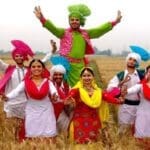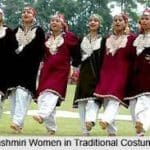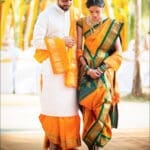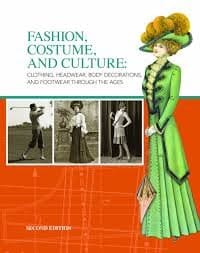Fashion

Fashion is a popular aesthetic expression at a particular period and place and in a specific context, especially in clothing, footwear, lifestyle, accessories, makeup, hairstyle, and body proportions.[1] Whereas a trend often connotes a peculiar aesthetic expression and often lasting shorter than a season, fashion is a distinctive and industry-supported expression traditionally tied to the fashion season and collections.[2] Style is an expression that lasts over many seasons and is often connected to cultural movements and social markers, symbols, class, and culture (ex. Baroque, Rococo, etc.). According to sociologist Pierre Bourdieu, fashion connotes “the latest fashion, the latest difference.”[3]
Even though they are often used together, the term fashion differs from clothes and costumes, where the first describes the material and technical garment, whereas the second has been relegated to special senses like fancy-dress or masquerade wear. Fashion instead describes the social and temporal system that “activates” dress as a social signifier in a certain time and context. Philosopher Giorgio Agamben connects fashion to the current intensity of the qualitative moment, to the temporal aspect the Greek called kairos, whereas clothes belong to the quantitative, to what the Greek called Chronos.[4]
Exclusive brands aspire for the label haute couture, but the term is technically limited to members of the Chambre Syndicale de la Haute Couture[5] in Paris.[2] It is more aspirational and inspired by art, culture and movement. It is extremely exclusive in nature.
With increasing mass-production of consumer commodities at lower prices, and with global reach, sustainability has become an urgent issue amongst politicians, brands, and consumers
Fashion Costume

Costumes of All Nations – Franks A.D. 800 (1882) Examples of a range of costumes suitable for specific individuals at a particular epoch. In later periods, once authentic costume may be revived or copied for theatrical purposes.
Costume is the distinctive style of dress of an individual or group that reflects class, gender, profession, ethnicity, nationality, activity or epoch.
The term also was traditionally used to describe typical appropriate clothing for certain activities, such as riding costume, swimming costume, dance costume, and evening costume. Appropriate and acceptable costume is subject to changes in fashion and local cultural norms.[1]
“But sable is worn more in carriages, lined with real lace over ivory satin, and worn over some smart costume suitable for an afternoon reception.” A Woman’s Letter from London (23 November 1899).[2]
This general usage has gradually been replaced by the terms “dress”, “attire”, “robes” or “wear” and usage of “costume” has become more limited to unusual or out-of-date clothing and to attire intended to evoke a change in identity, such as theatrical, Halloween, and mascot costumes.
Before the advent of ready-to-wear apparel, clothing was made by hand. When made for commercial sale it was made, as late as the beginning of the 20th century, by “costumiers”, often women who ran businesses that met the demand for complicated or intimate female costume, including millinery and corsetry..
Costume Design

Costume design is the creation of clothing for the overall appearance of a character or performer. Costume may refer to the style of dress particular to a nation, a class, or a period. In many cases, it may contribute to the fullness of the artistic, visual world which is unique to a particular theatrical or cinematic production. The most basic designs are produced to denote status, provide protection or modesty, or provide visual interest to a character.[1] Costumes may be for a theater, cinema, or musical performance but may not be limited to such. Costume design should not be confused with costume coordination which merely involves altering existing clothing, although both create stage clothes.
Four types of costumes are used in theatrical design: historical, fantastical, dance, and modern.
State Wise Costume
Assam

Among all the states of India, the north eastern state of Assam boasts of a traditional attire that is uniquely beautiful. The Assamese women take pride in their graceful attire of mekhela sador that which makes them look ethereally beautiful. Made from lustrous silk variants paat or muga and eri, this two piece ensemble endows a certain grace that which is very fresh and enticing in the very look of it.
Punjab

Punjab is one of the most colorful states of the country and the Punjabis are well known for their energy and fun loving spirit. The traditional dress of the Punjabis reflect this enthusiasm and free spirited nature. The women of the state wear colorful ghagras which are now mostly replaced by the more functional, but equally traditional salwar suits.
Patiala salwars and churidaars are very common dress styles of the state, that which now are staple ensembles pan India. The Punjabi men generally wear kurta and muktsari pajamas, that which has replaced the more traditional tehmats.
Jammu and Kashmir

The cold terrains that dominate the Paradise on Earth make the traditional dress code of Jammu and Kashmir to be essentially winter clothes. Like its bright red apples for which the state is so famous, the dress of Jammu and Kashmir is equally steeped in a delightful fusion of bright colors.
Pheran is the traditional wear of the state, common to men and women, both Hindus and Muslims with some variations. Just a reminder of the unity in diversity that India so beautifully encompasses.
Kerala

As a state that is highly seeped in tradition while offering a generous does of modernity, Kerala’s ethnic wear still rules the culture and customs of the state.
Keralian women wear the traditional off white sari with golden border called the mundum neriyathum. A two piece wonder, the mundum neriyathum consists of the lower part of the garment called mundu that is worn waist downwards and the upper part of it called the neriyathu which is either tucked into the blouse or worn over the left shoulder.
Andhra Pradesh

Andhra Pradesh much like other south Indian states has a traditional wear that can be considered a staple for the region, though with variations.
Andhra women wear original handloom sarees, mostly silk that lends a rich texture and color to them. With its famous weaving and dying industry, Andhra Pradesh churns out a variety of fabrics that has a rich legacy to them. The younger women generally wear a two piece traditional sari called the Langa Voni
Haryana

Like its neighbour Punjab, the state of Haryana also features traditional dresses that are a riot of colors. A special type of ghagra choli is the traditional dress for women, that which includes a long ankle length skirt called the daaman, a kurti and a chunder as odhni. The chunder, splashed in color and shiny laces is the most dramatic part of the ensemble while the daaman is equally vibrant and flashy.
Men in Haryana generally sport an all white Dhoti- kurta ensemble, accompanied by the traditional headgear called Pagri and equally traditional footwear called jutis. Tradition dictates the whiteness of the attire as a status symbol for men while women make multiple pleats in their ghagra as their own show of opulence.
Gujarat

Gujarat is another Indian state that embraces colors in its culture, as also in its traditional attires. Womenfolk of Gujarat wear the traditional dress called the Chaniyo Choli that is a three piece attire with a ghagra, choli and a head veil.

Chaniyo is the lower part of the dress and is a petticoat like ghagra embedded with glass pieces that complements the ornaments that adorn their upper part of the body. The choli or blouse accompanies the ghagra and the look is completed by the odhni called polku.Gujarati men wear dhotis or churidar pajamas and kurtas or bandis, traditionally called Chorno and Kediyu that are paired with rich colored headgear as the turbans.
Maharashtra

Culturally vibrant and traditionally resplendent in all it glory, Maharashtra’s clothing culture is iconic and known all across the country. Even as the saree is the traditional attire for women of the state, the fact that it happens to be a nine yard wonder makes it all the more classic.Known as Nauwari saadi or Lugda, the sarees are worn upto knee length with cholis are remarkable for their characteristic style. These bright colored lengths of wonder exhibit a border and pallu in same colors, but one that is most commonly in contrast with the color of the saree. Equally exceptional is the wearing style of the saree that which resembles tying a dhoti and therefore does not need a petticoat to be worn underneath. The cholis also carry a style of their own, as they are fastened with knots.
Maharashtrian men traditionally wear dhotis known as Dhotar, which they pair with a tight fit short sleeved shirt called Pheta and accompanied by headdresses called Pagadi.
Culture

Culture is an umbrella term which encompasses the social behavior and norms found in human societies, as well as the knowledge, beliefs, arts, laws, customs, capabilities, and habits of the individuals in these groups.
4 Types Of Culture
1.Western Culture
2.Eastern Culture
3.Latin Culture
4.African Culture
1.Western Culture
The term “Western culture” has come to define the culture of European countries as well as those that have been heavily influenced by European immigration, such as the United States, according to Khan University. Western culture has its roots in the Classical Period of the Greco-Roman era and the rise of Christianity in the 14th century.Other drivers of Western culture include Latin, Celtic, Germanic and Hellenic ethnic and linguistic groups. Today, the influences of Western culture can be seen in almost every country in the world.
2.Eastern Culture
Eastern culture generally refers to the societal norms of countries in Far East Asia (including China, Japan, Vietnam, North Korea and South Korea) and the Indian subcontinent. Like the West, Eastern culture was heavily influenced by religion during its early development, but it was also heavily influenced by the growth and harvesting of rice, according to the book “Pathways to Asian Civilizations: Tracing the Origins and Spread of Rice and Rice Cultures” by Dorian Q. Fuller. In general, in Eastern culture there is less of a distinction between secular society and religious philosophy than there is in the West.
3.Latin Culture
Many of the Spanish-speaking nations are considered part of the Latin culture, while the geographic region is widespread. Latin America is typically defined as those parts of the Central America, South America and Mexico where Spanish or Portuguese are the dominant languages. Originally, the term “Latin America” was used by French geographers to differentiate between Anglo and Romance (Latin-based) languages, according to the University of Texas. While Spain and Portugal are on the European continent, they are considered the key influencers of what is known as Latin culture, which denotes people using languages derived from Latin, also known as Romance languages.
4.African Culture
The continent of Africa is essential to all cultures. Human life originated on this continent and began to migrate to other areas of the world around 60,000 years ago, according to the Natural History Museum in London. Other researchers, like those from Estonian Biocentre in Tartu, believe that the first migration may have been much earlier, as early as 120,000 years ago. Researchers come to these conclusions by studying human genomes from various cultures to trace their DNA to common ancestors. Fossil records also factor into some of these theories.
Fashion And Culture
The fashion industry is all about making bold, edgy, and trendy fashion statements. The term fashion includes being different from the crowd or making a statement through clothes and accessories that set you apart. When fashion comes into the picture, culture is an integral part of it.
Fashion and culture go hand in hand. Our clothes are a way to express our personality, where we come from, who we are, what we do, etc. Culture influences our lifestyle in major ways, especially by way of modernization, art and technological innovation. Eastern and Western cultures and lifestyles originated and developed over thousands of years, as the age-old saying goes – “Rome wasn’t built in a day.” As such, the clothing styles and fashions have been in flux. A major part of both cultures’ self-expression involves fashion, from special occasions to everyday attire.
Let’s take a look at how the different cultures and fashions have evolved eastern and western styles leading to varying sartorial tastes and unique methods of design and creation.
The Past

If we talk about the East, we see customary clothes like the Japanese Kimono and the Indian Saree belonging to a specific culture. Men and women have been wearing these traditional pieces for centuries, with minor style variations taking place over time. These outfits are still very appropriate for cultural occasions and festivals, and they continue to signify the acceptance of their culture. Now we see kimonos being worn by women, and even men from the West; denoting it as comfort wear, they are styled as part of work wear and everyday attire.
Indian women are also styling the Indian saree with jackets, corsets, etc. marking it as a formal option for their everyday work attire and for various other events. Pre-stitched and pre-draped sarees are all the rage right now, accepted and adored by women all over the world. Kurti’s worn with jeans are all the rage with the younger generation.
The Eastern style has not lost its customary clothing sensibilities, they have just evolved to suit the lifestyles of people in the modern age. We see this with many high-fashion brands and designers that use traditional motifs and silhouettes in new age ensembles. Big brands like Louis Vuitton, Marchesa, and Issey Miyake have celebrated the kimono on the runway, and designers like Sabyasachi and Masaba are adding a touch of modernity to the classical Indian sari and lehenga.
As for Western fashion and style, there have been major changes in their dressing over time. Indeed there was a certain signature touch to it in earlier times but now it’s about comfortable, on-the-go pieces and wearable items. Take corsets, for instance, corsets defined the western era for decades. Now corsets and bustiers have largely fallen out of fashion and however, the few that are sold just imitate the style and are modified for wearability. The same goes for three-piece formal clothing, this kind of formal wear option was mostly visible during official events and occasions; today men’s formals have taken over the entire western world in the form of casual wear suits, workwear suits, athleisure suits, evening wear pantsuits and more. Meanwhile, the three-piece have largely fallen out of favor and are reserved for extremely formal occasions.
The Present

Today, Western clothing displays a casual kind of style mainly because it is a more secular society. The West is the trendsetter of the current fashion world. Their clothing includes denim wear, tees, skirts, pants, shorts and more. Here, religion doesn’t define the dress code. The main definition of western-style would be anything comfortable and trendy, whatever attracts and flatters the body is worn usually. European clothing tends to follow the same trend. This style is heavily influenced by liberal thought, with huge experimental and avant-garde fashions emerging in the area.
The Future

The fashion sensibilities of both societies are shifting now. The West is beginning to appreciate the elaborate fabrics and rich colors of the East, while the East is gradually beginning to express themselves with clothing and trendy accessories, also allowing individualism to set foot into age-old traditions. An iconic example of this would be Rihanna’s MET Gala 2015 look by Guo Pei. The beautiful and intricate yellow gown was a reflection of China’s past, expressed in a modern symphony.
Meanwhile, modern (shall we say millennial?) Indian brands like ‘NorBlack NorWhite’ are inventing new textiles suited to modern tastes and using them in traditional pieces. Their ‘Shimma Saree’ paired with a mesh blouse and sports bra is a completely new take on the traditional ensemble.
Both these societies today are starting to merge their fashion industry and clothing traditions to create a new, contemporary and more globally accepted range. The most up-to-date fashionistas today will be those who would be willing to embrace the cultural blending of the East and the West, making the new global style their very own!
Conclusion
Here’s a tip for you by I Knock Fashion, if you’re looking for an eastern piece of clothing like embroidered tunics, beaded neckline dresses and shirts, jeweled handbags with Sari fabrics, you can easily find it any store or designer line. Women out there here’s a wardrobe tip for you the Kurta top, as simple as it can be it stands out from the rest because of its beaded detail you can also go for A Nehru jacket, born in the 1940s and remarketed in the 1960s, it is an acclaimed fashion piece and never runs out of fashion.
If you are in search of designers and fashion who bids on exotic eastern style in their creations lookout for Max Mara, Armani, Jean Paul Gaultier, Gianfranco Ferr and Versace, they offer pants made with kimono fabrics, mao necklines, printed belts and even oriental type footwear with the use of heavy silk
Referance – Book ,
Sara Pendergast
Thank you

